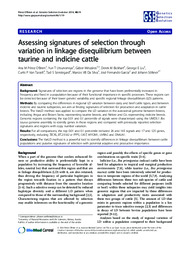Assessing signatures of selection through variation in linkage disequilibrium between taurine and indicine cattle.
Assessing signatures of selection through variation in linkage disequilibrium between taurine and indicine cattle.
Autoria: O'BRIEN, A. M. P.; UTSUNOMIYA, Y. T.; MÉSZÁROS, G.; BICKHART, D. M.; LIU, G. E.; TASSEL, C. P. V.; SONSTEGARD, T. S.; SILVA, M. V. G. B.; GARCIA, J. F.; SÖLKNER, J.
Resumo: Signatures of selection are regions in the genome that have been preferentially increased in frequency and fixed in a population because of their functional importance in specific processes. These regions can be detected because of their lower genetic variability and specific regional linkage disequilibrium (LD) patterns. By comparing the differences in regional LD variation between dairy and beef cattle types, and between indicine and taurine subspecies, we aim at finding signatures of selection for production and adaptation in cattle breeds. The VarLD method was applied to compare the LD variation in the autosomal genome between breeds, including Angus and Brown Swiss, representing taurine breeds, and Nelore and Gir, representing indicine breeds. The conclusions are that VarLD method is a powerful tool to identify differences in linkage disequilibrium between cattle populations and putative signatures of selection with potential adaptive and productive importance.
Ano de publicação: 2014
Tipo de publicação: Artigo de periódico
Unidade: Embrapa Gado de Leite
Palavras-chave: Genetic improvement, Indicine, Linkage disequilibrium, Minor allele frequency, Taurine
Observações
1 - Por padrão são exibidas publicações dos últimos 20 anos. Para encontrar publicações mais antigas, configure o filtro ano de publicação, colocando o ano a partir do qual você deseja encontrar publicações. O filtro está na coluna da esquerda na busca acima.
2 - Para ler algumas publicações da Embrapa (apenas as que estão em formato ePub), é necessário ter, no celular ou computador, um desses softwares gratuitos. Sistemas Android: Google Play Livros; IOS: iBooks; Windows e Linux: software Calibre.
Acesse outras publicações
Acesse a Base de Dados da Pesquisa Agropecuária (BDPA) para consultar o acervo completo das bibliotecas da Embrapa.

